
Stanley H. Smith, AKA “Tiny” at the University of Kentucky. Stanley would have graduated with the Law College Class of 1919, had he not given his life for our country. “All who knew Stanley Smith say they never came in contact or were associated with a finer young man, a youth who promised much”.
Introducing Stanley H. Smith, U.S. Navy Yeoman Second Class, One of Cranford’s 86
Written by Janet Cymbaluk Ashnault, Proofread by Don Sweeney, Research by Stu Rosenthal and Janet Cymbaluk Ashnault, Military Expertise by Vic Bary
The Cranford 86 project operates entirely by donations. At times we are blessed with generous monetary gifts from local organizations, such as Cranford Knights of Columbus, Cranford Jaycees and the Cranford Historical Society. But, mainly it is the benevolence of our individual supporters who sponsor banners, purchase tribute books and t-shirts or place a few dollars in our donation jar on Memorial Day. These are people who believe in our mission and want to ensure that long after we are all gone, the 86 men from Cranford who made the ultimate sacrifice for our country, do not become “just names”. When our job is finished, each of the 86 will have a face put to their name and the story of their life, their military service and their death, published in print and online. A few years back, Cranford residents Don Smith and his wife Loretta were kind enough to sponsor not one, but two banners for the Cranford 86 servicemen who share their surname, Roderick W. Smith Jr. and Stanley H. Smith. Don and Loretta are long-time supporters of our project and Don is a retired U.S. Army colonel. The Smiths have been patiently waiting to learn the stories of these two brave men, the first of which, that of Stanley H. Smith, we bring to you here.
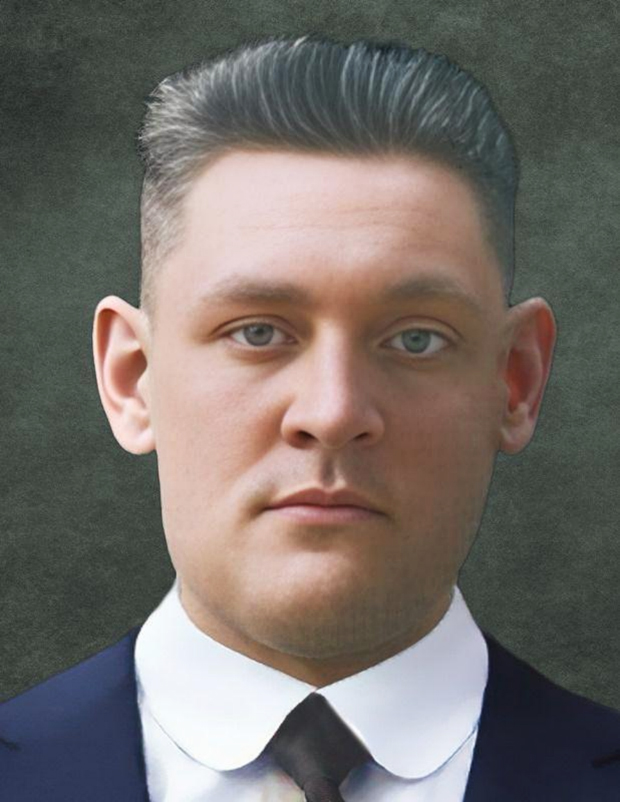
Researching Our Heroes
A routine part of our research methodology includes creating a basic family tree for each of our Cranford 86 servicemen. We use the power of Ancestry.com and its affiliates to establish facts about family members, residence, occupation and military service and to also connect us with others that are researching this same person. All of this information is needed to connect the dots and validate our findings. Ancestry will also find newspaper articles from all over the country that make mention of our Cranford heroes. This, combined with the Cranford Public Library’s searchable archives of over 100 years of our own local newspaper and Cranford High School yearbooks, can give us substantial information about our serviceman, even if we are flying blind, without the help of a family member. Stanley H. Smith lived over 100 years ago and with such a common surname, we knew that we had a bit of a challenge ahead of us. Luckily, Stanley’s middle name, Hartwell, is a bit unusual and we are grateful that it was used quite a bit.
It was somewhat surprising when the information that we began to collect took us far from Cranford, to northwestern Pennsylvania, and we hoped that we were barking up the right tree. In 1900, “a” Stanley Smith lived with his parents, his brother Wilbur and seven other siblings in Hamlin Township, Pennsylvania. The father, Elonzo I. Smith was a stone mason and this Stanley Smith was age 13 at the time, an appropriate age for someone who eventually might serve in the First World War. We also made note of a newspaper article from 1900 where Stanley and Wilbur Smith were listed as attending intermediate school in the somewhat nearby town of Emporium, Pennsylvania. In 1910, Stanley is not living with his family and in both the 1920 and 1930 censuses, after Stanley Hartwell Smith’s death, we see that this family has moved to Sugar Grove, Pennsylvania.

In 1910, we may have found Stanley working as an Officer/Attendant in Montgomery Township, N.J. at the New Jersey State Village of Epileptics. The facility was created to provide a place for those afflicted with epilepsy, keeping them out of insane asylums or other less decent institutions of those times. The village was completely autonomous and the men in Stanley’s care were farm workers there. The Stanley Smith shown here is the correct age and is from Pennsylvania, but we would need more facts to be sure that this was indeed Stanley Hartwell Smith
Stanley’s Higher Education
Although we are not yet sure how this will bring us to Cranford, things start to connect when we find the “Commencement Issue” of The Citizen newspaper from Berea, Kentucky. The commencement referred to is that of Berea College on June 6, 1916 and Stanley Hartwell Smith from Emporium, Pennsylvania is noted as a graduate from the “Academy Department”. This fact, linking Stanley Hartwell Smith to the town of Emporium, helps to confirm his connection to the large Pennsylvania Smith family that we mentioned above. Berea College still exists today and back in 1916 it was touted that the school’s tuition cost had not increased in twenty-four years, and that “schooling at Berea is still within reach of every family that has grit and common sense”. The newspaper describes the joyful events of commencement weekend and we see that Stanley is part of the entertainment with his portrayal of King Claudius in a production which includes a scene from Hamlet. The gaiety of this issue of The Citizen, reflected hope of a bright future for each of the Berea graduates. However, lurking here and there within the newspaper’s pages were some ominous words regarding the war which had been raging overseas for the past two years. In 1916, the United States of America was not actively involved in the conflict, but we wonder how much the possibility of war weighed on the minds of these young people.

By far, the most charming photograph that we have in our possession is that of WWI Yeoman Second Class, Stanley H. Smith. Wearing a white sailor’s cap and dark sweater, Stanley is posed with a small bulldog, a popular mascot at the time. At first glance he appears to be standing on the deck of his ship, but closer scrutiny reveals that he is actually standing in front of a studio backdrop. Photographic portraits of this type were very popular as well as affordable in the early 1900’s. Note that Stanley is wearing “puttees”, which are leather or canvas leggings worn for protection and support.
Stanley Enters Law School and America Joins The Great War
The Great War, as World War I was referred to at the time, had begun in 1914 and its conflicts occurred in Europe, the Middle East, Africa, Asia and at sea. Beginning when Austria-Hungary declared war on Serbia, many countries were drawn into the conflict pitting the Central Powers (Germany, Austria-Hungary, Ottoman Empire and Bulgaria) against the Allies (France, UK, Russia, Italy, Japan and eventually, the U.S.). Historians dispute as to what triggered President Woodrow Wilson to enter our country into this war, but most agree that attacks made by German submarines on U.S. passenger and merchant ships in 1917 was the primary motivation.
Following his graduation from Berea, Stanley Smith, aspiring to enter the legal profession, enrolled in law school at the University of Kentucky. From the few photos that we have of Stanley, he does look like a large, well-built fellow. This fact was confirmed, in our opinion, when we discovered that his nickname at school was “Tiny” a moniker apparently bestowed to him playfully, rather than accurately. Stanley was a member of the Phi Alpha Delta law fraternity, as well as the Pi Kappa Alpha social fraternity and was well-known on the Lexington campus. He made good use of his spare time performing stenographic work in the university’s main office. The trajectory of Stanley’s life, along with so many others, was changed on April 6, 1917, when the U.S. joined the Allies and declared war against Germany. For the next nineteen months the United States would be embroiled in bloody battle on land, sea and in the air. When the call for volunteers went out, Stanley Smith was in his second year of law school, destined to graduate in the class of 1919. As with so many of our Cranford 86 stories, I am left in awe when these young people with promising, fulfilling, prosperous lives laid out in front of them, drop everything, joining our country to fight in a world war. One week later, Stanley Smith, along with classmate William J. Collins, left school and traveled to Cincinnati, Ohio to enlist in the U.S. Navy.
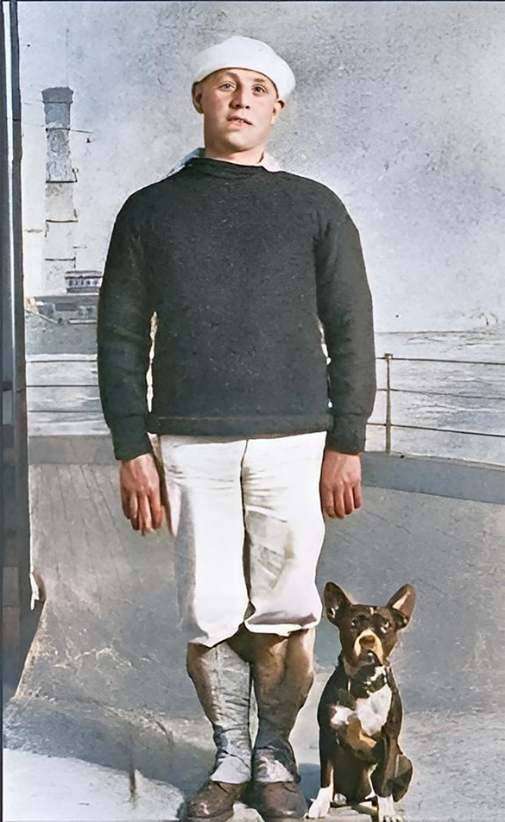
Yeoman 2C Stanley Hartwell Smith
As the war effort in our country swung into high gear and recruitment accelerated, the Navy needed good people in its administrative positions on board ship. Considering the education that Stanley Smith already had under his belt, the Navy saw fit to designate him as a “yeoman”. Yeomen performed a wide range of clerical type jobs supporting the ship and its personnel. Stanley would have attended Yeoman’s School either in Newport, Rhode Island, San Francisco, California or at the New York Navy Yard. The training consisted of a four to six week refresher course in arithmetic, spelling and composition as well as instruction on Navy protocol. A final exam determined eligibility for the advanced training required to work in any of the following departments, supply officer, general bookkeeping, executive officer, pay officer and commanding officer. The list of duties performed by yeomen was endless. For example, in the pay-officer assignment, duties were centered around payrolls and banking and included the computation of salary for officers and enlisted men, including any allowances, bounties, or extra pay, and the preparation of the payroll checks of their shipmates. Yeomen were also responsible for calculating credit and interest on payroll savings accounts. Having strong skills in arithmetic was an absolute requirement in this department. Well educated from the start, Stanley quickly advanced to the highest paying level of yeoman, Yeoman Second Class (Y2C) and was assigned to serve on the Sampson-class Destroyer, USS Wilkes.
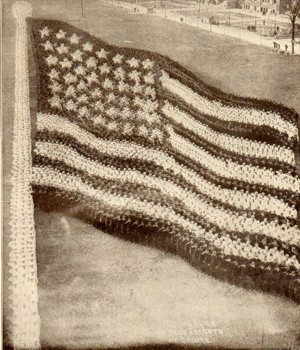
U.S. involvement in The Great War required the largest mobilization of its military since the Civil War. A way to keep morale and spirits high, human flag photos became a “viral” trend. Created with over 10,000 sailors, this photo was taken at Naval Station Great Lakes.
On the USS Wilkes
It is likely that Yeoman Smith joined the crew of the Wilkes by June 15, 1917, as it left New York City as part of the first American troop convoy sent to Europe. As an escort ship, the USS Wilkes and twelve other destroyers were to ensure safe passage of the convoy to its destination. Four cruisers and two armed yachts provided additional protection for the fourteen merchant steamships, two fuel tankers and three Navy transports which were bringing cargo to France. The ships were filled with American troops, materials, draft animals, and supplies. The group was originally headed for Brest, France, until they were fired upon and enemy torpedoes surged through the convoy, barely missing several ships. Passive sonar aboard the Wilkes (passive meaning that it only listens and does not emit its own signal), detected U-boats nearby. The ships scattered and regrouped the next morning, eventually safely arriving at Saint-Nazaire, France on June 26th. I would imagine that this convoy was manned with a high percentage of brand new recruits who had just gotten their first small taste of warfare at sea.
With a stop in Portsmouth, England, the USS Wilkes voyaged to its permanent European base, Queenstown (now Cobh), Ireland, arriving on July 6, 1917. The Wilkes would operate out of Queenstown for the duration of the war, protecting what was known as the “Western Approaches”. Aptly named, the Western Approaches is the area of the Atlantic Ocean to the west of the British Isles. All shipping to these island nations passed through this area and the need for it to be staunchly guarded was great. Ships like the Wilkes were responsible for destroying enemy submarines, protecting and escorting merchant vessels and the rescue of crews and passengers of torpedoed ships. The ship’s duty was anything but routine or mundane, and their time was spent mostly at sea in the tempestuous North Atlantic. Most likely, Stanley Smith was an active participant when the Wilkes rescued twenty-three survivors of the SS Purley, a British merchant ship which was torpedoed on July 25, 1917. When the destroyers did get into port for provisioning, it was only for a day or two, and we imagine that the yeomen, just as busy as the rest of the crew, were hustling the documents, receipts, currency, letters, forms, etcetera, that needed to move on and off the ship during this brief time period.

Yeoman School, New York Navy Yard c. 1910-19. Yeoman’s training included the use and proper care of a typewriter.
Finally, the Cranford Connection
Up until this point in our research, we still did not know how Stanley Hartwell Smith’s name ended up on the monument in Cranford’s Memorial Park on Springfield Avenue. It was when we uncovered the sad details of Yeoman Smith’s accidental death, that the mystery was solved.
In the U.S. Navy Casualties Book we discovered a very succinctly written passage:
“13 September 1917 U.S.S. WILKES. At about 7:35 p.m. while walking aft on the starboard side of the ship, the following man slipped, fell, went through the life lines and was drowned:- SMITH, Stanley Hartwell Yeoman 2 class”
There was no information regarding weather conditions, ocean swells, rescue attempts or how a man of Stanley’s size slipped through the life lines which surround the deck. Although Stanley’s parents were alive at the time, his next of kin was recorded by the Navy as: “Aunt, Harriet I. Russell, 25 North Avenue West, Cranford, N.J.” A quick check of census records of the Pennsylvania Smith family showed that Stanley’s mother did indeed have a sister Harriet. So with his address of record noted by the U.S. Navy as being in Cranford, this is how Yeoman Second Class Stanley Hartwell Smith became one of Cranford’s 86. He was one of America’s best and brightest patriotic young men and regardless of whether or not he ever even set foot in our town, we embrace him as our own.

Taken May of 1917, the launching of the torpedo boat destroyer “Wilkes” at Cramp Shipyards, Philadelphia, PA. The vessel was fitted with four torpedo tubes and two anti-aircraft guns.
Honoring Yeoman Smith
W. T. Lafferty, the dean of the University of Kentucky’s College of Law, spoke of Stanley Smith, “as a student and a man, Mr. Smith was strong, able and courageous, bidding fair to do much in his chosen profession”.
Certainly a reflection of this man’s character, shortly after his death, Stanley’s sacrifice was honored in several of the places through which he passed in his life. Designated as lost at sea, his name appears on the Tablets of the Missing at Suresnes American Cemetery and Memorial in France. Stanley Smith was the first University of Kentucky student to be lost in WWI and a plaque on campus there bears his name. In 1925, his fraternity house was renamed “Stanley Hartwell Smith Memorial Hall”. Of course, the name Stanley H. Smith appears on Cranford’s WWI tablet at Memorial Park. A granite monument in Cherry Hill Cemetery, Warren County, Pennsylvania is inscribed with Stanley’s name and his birth and death years. The Warren County Historical Society was kind enough to send us a magazine page indicating that Stanley was the first resident from that county to die in WWI. These memorials are all beautiful and respectful gestures of gratitude. Unfortunately, anyone who comes across one of them today, unless they invest time and effort, will not know much more about Stanley than his name. Born out of Cranford’s steadfast Memorial Day traditions, the Cranford 86 project has now reintroduced Stanley Hartwell Smith to all. Via a simple internet search, Stanley’s image will appear and his story will be told. We can’t think of a better way to thank him for his service.

Sailor in foul weather gear clings to a life line as waves wash over the ship’s deck. It is easy to see how the power of the sea could quickly take a life.
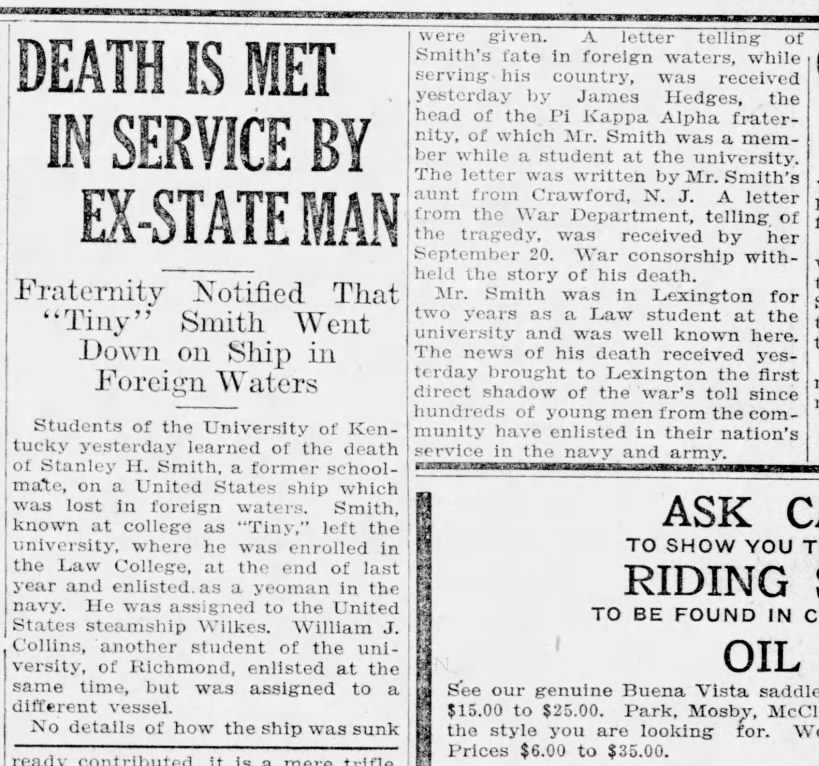
Newspaper articles like this one from the Lexington Herald, dated Oct of 1917, provided us with a wealth of information. This is how we learned of Stanley’s nickname. Note the misspelling of Cranford, in reference to Stanley’s aunt who wrote a letter to the university informing them of Stanley’s death.
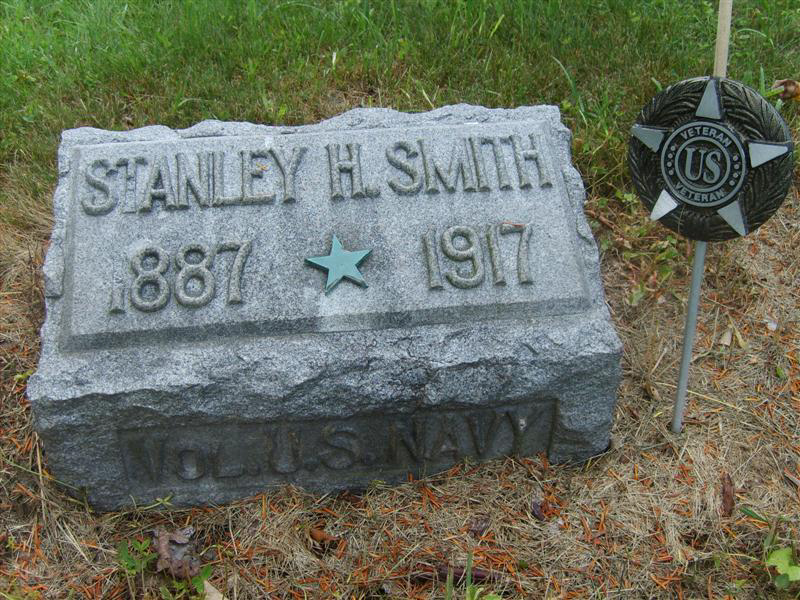
This granite monument honoring Stanley H. Smith is located in Cherry Hill Cemetery, Sugar Grove, PA, where Stanley’s parents are buried. Since Stanley was lost at sea, this type of memorial is known as a “cenotaph”, which is defined as “a monument to someone buried elsewhere, especially one commemorating people who died in a war”. The word cenotaph is derived from the Greek words meaning “empty tomb.”
